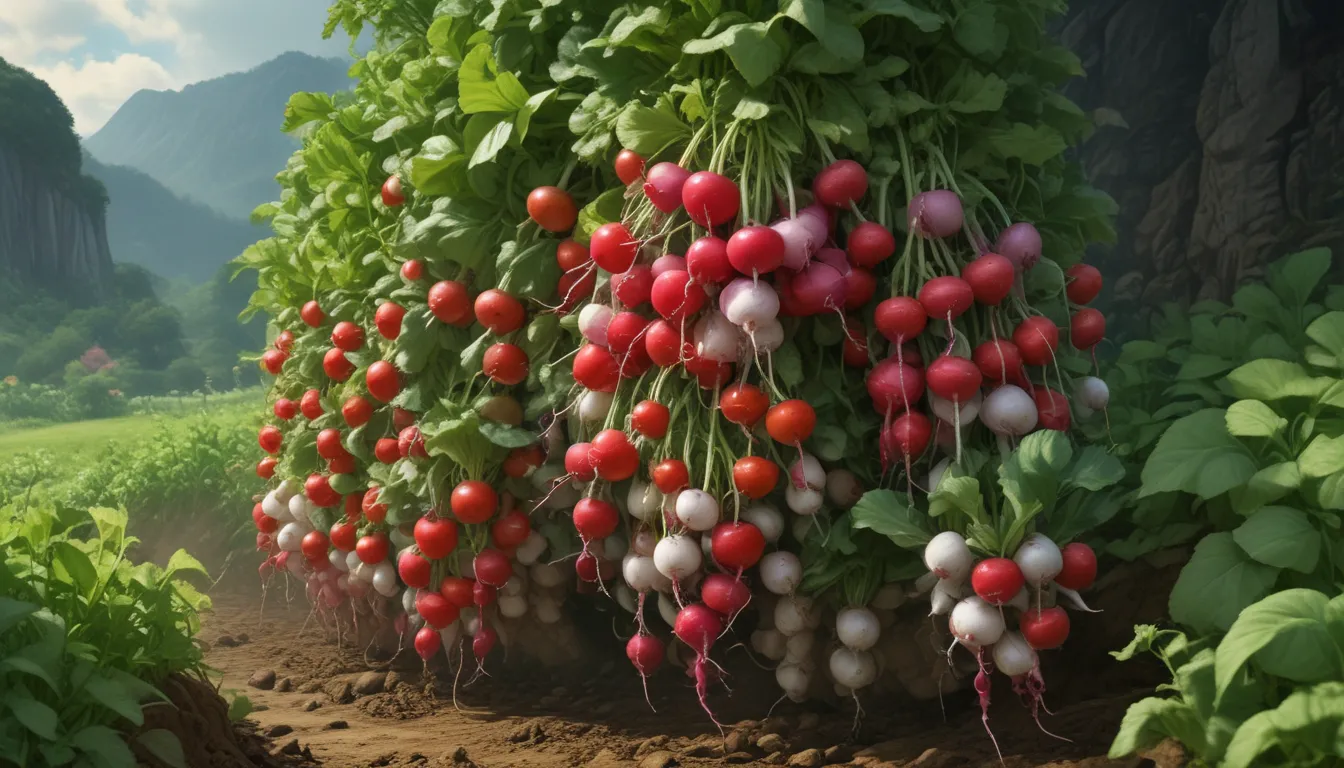A Complete Guide to Planting and Growing Radishes

Are you looking to add some colorful, crunchy goodness to your garden? Look no further than radishes! These vibrant vegetables are not only beautiful but also quick to mature and incredibly versatile in the kitchen. Whether you’re a seasoned gardener or just starting out, radishes are a must-have in your backyard garden.
Why Radishes?
Radishes, scientifically known as Raphanus sativus, belong to the Brassicaceae family, alongside popular vegetables like arugula, broccoli, and kale. They have a rich history that dates back to Southeast Asia, where they were among the earliest cultivated crops. Ancient Egyptians, Romans, and Europeans have all enjoyed the taste and versatility of these root vegetables, making them a staple in gardens around the world.
Here’s why radishes are a great addition to any garden:
- Quick to mature, with some cultivars ready to harvest in just over two weeks
- Reliable seed germination, making them easy to grow
- Nutritious and delicious, with edible roots, leaves, and even seeds
- Suitable for year-round cultivation, with different varieties for every season
So, whether you’re a radish aficionado or just curious to try something new, let’s dive into the wonderful world of radishes and learn how to plant and grow them in your garden.
What You’ll Learn
In this guide, we’ll cover everything you need to know to grow mouthwatering radishes successfully. From cultivation and history to propagation, growing tips, and delicious recipes, we’ve got you covered. Here’s a sneak peek of what you’ll find in this article:
- Cultivation and History of Radishes
- Propagation Techniques for Growing Radishes
- How to Grow Radishes Successfully
- Essential Growing Tips for Healthy Plants
- Maintenance Practices for Radish Crops
- Recommended Cultivars to Select for Your Garden
- Managing Pests and Disease in Radish Plants
- Harvesting and Storage Guidelines
- Preserving Radishes Through Drying and Pickling
- Delicious Recipes and Cooking Ideas Featuring Radishes
- Quick Reference Growing Guide for Easy Reference
Stay tuned as we explore the fascinating world of radishes and unlock the secrets to growing these fiery gems in your garden.
Cultivation and History
Radishes have a rich history that traces back to their origins in Southeast Asia, where they were among the earliest cultivated crops. Ancient civilizations like the Egyptians and Romans prized these easygoing veggies, and European explorers introduced them to the Americas in the 16th century.
These root vegetables come in a wide range of sizes, shapes, and colors, from the classic red ‘Cherry Belle’ to the long and elegant daikons. They can be grown as annuals in USDA Hardiness Zones 2 to 11, making them a versatile choice for gardeners across different climates.
Propagation Techniques
Growing radishes from seed is a straightforward process that involves preparing the soil, sowing the seeds, and providing the right conditions for germination. Here’s a step-by-step guide to propagating radishes successfully:
- Prepare the soil by loosening it and adding well-rotted compost.
- Sow the seeds at the recommended depth, spacing them according to the cultivar.
- Keep the soil moist and provide adequate sunlight for germination.
- Thin the seedlings as they grow to ensure healthy root development.
- Consider starting seeds indoors for a head start on the growing season.
By following these propagation techniques, you can ensure a bountiful harvest of fresh radishes in your garden.
How to Grow Radishes Successfully
Radishes thrive in loose, rich, and well-draining soil with a pH between 6.0 and 7.0. They prefer full sun exposure and moderate moisture levels to develop healthy, tasty roots. Consider using raised beds or containers for optimal soil conditions and drainage.
To support radish growth, fertilize the soil midway through the growing season with an all-purpose fertilizer. Avoid high-nitrogen fertilizers, as they can lead to excessive leaf growth at the expense of root development. Companion planting with beans, beets, cucumbers, and other compatible crops can help repel pests and promote healthy growth.
Essential Growing Tips
To ensure a successful radish harvest, keep the following growing tips in mind:
- Maintain loose, rich soil with proper drainage and pH levels.
- Keep the soil consistently moist to prevent root cracking or woody texture.
- Avoid high-nitrogen fertilizers that can hinder root growth.
- Practice companion planting to deter pests and promote plant health.
By following these tips, you can grow vibrant, flavorful radishes in your garden with ease.
Maintenance Practices
Radishes are relatively low-maintenance plants that require minimal cultivation and weeding. Avoid deep hoeing, as the roots grow close to the soil surface and can be easily damaged. Weed carefully to avoid disturbing the roots, and consider using shade cloth on hot days to prevent bolting.
If your radishes show signs of bolting, harvest them immediately to prevent woody or bitter roots. Proper maintenance practices can help you enjoy a bountiful harvest of fresh radishes throughout the growing season.
Recommended Cultivars to Select
With a wide range of radish varieties available, choosing the right cultivar can enhance your garden and culinary experience. Some popular radish cultivars include:
- Black Spanish Round: A classic winter radish with spicy, pungent roots.
- Cheong Du: A Korean radish with a strong, flavorful taste and stout shape.
- Cherry Belle: A bright red heirloom radish with a crisp, mild flavor.
- Miyashige: A snow-white daikon with tender, elongated roots.
- Watermelon: A colorful radish with a sweet, mild flavor and vibrant fuchsia interior.
Each cultivar offers unique flavors and textures, allowing you to experiment with diverse radish varieties in your garden.
Managing Pests and Disease
While radishes are relatively disease-resistant, they can attract common pests like root maggots and flea beetles. To manage these pests, practice crop rotation, use floating row covers, and maintain proper sanitation practices to prevent infestations.
Damping off, a fungal disease that affects seedlings, can be prevented by using clean soil and containers, watering at the soil level, and maintaining healthy seedlings. By staying vigilant and addressing pest and disease issues promptly, you can protect your radish crop and ensure a successful harvest.
Harvesting and Storage Guidelines
Harvest radishes when they reach maturity to prevent woody or bitter roots. Use the days to maturity listed on the seed packet as a guide, and look for visible shoulders popping out of the ground to indicate readiness for harvest.
For optimal storage, wash radish roots thoroughly, trim the tops, and store them in plastic bags or covered containers in the refrigerator. Spring and summer varieties should be consumed promptly, while winter varieties can be stored for several months in cool, moist conditions.
By following these harvesting and storage guidelines, you can enjoy fresh radishes throughout the growing season and beyond.
Preserving Techniques
If you have an abundance of radish greens, consider drying them to make mucheong, a popular Korean dish. Wash the leaves and dry them in a dehydrator or oven on a low setting until crisp. You can also dry radish roots by slicing them thinly and baking them until crisp for a flavorful snack.
For a unique twist, pickle radishes to create tangy, crunchy treats that can elevate salads, sandwiches, and more. Explore different preservation techniques to make the most of your radish harvest and enjoy them year-round.
Recipes and Cooking Ideas
Radishes are incredibly versatile in the kitchen and can be used in a wide range of dishes, from salads and appetizers to main courses and side dishes. Try roasting, steaming, or sauteing radishes to experiment with different flavors and textures.
For a classic French-inspired appetizer, serve sliced radishes with butter, sea salt, and a glass of wine. Get creative with brunch by pairing radishes with potted shrimp or crab, watercress, and fresh bread. For a refreshing lunch option, create a sandwich with cream cheese, avocado, and radish matchsticks for a crunchy twist.
With an array of delicious recipes and cooking ideas, you can showcase the unique flavors and textures of radishes in your culinary creations. Let your creativity soar as you explore the delightful world of radish cuisine.
Quick Reference Growing Guide
For easy reference, here’s a quick summary of key information to help you grow radishes successfully:
- Plant Type: Biennial root vegetable
- Hardiness (USDA Zone): 2-11
- Season: Spring, fall, winter
- Exposure: Full sun
- Time to Maturity: Up to 70 days
- Spacing: At least 2 inches, depending on the variety
- Height: Up to 12 inches
- Water Needs: Moderate
- Common Pests and Diseases: Flea beetles, root maggots; damping off
By following this quick reference guide, you can cultivate healthy, vibrant radishes in your garden and enjoy a plentiful harvest throughout the growing season.
Conclusion: Unlock the Delights of Radish Gardening
Radishes are a delightful addition to any garden, offering vibrant colors, crisp textures, and versatile culinary uses. Whether you’re a seasoned gardener or a novice enthusiast, growing radishes can be a rewarding and enjoyable experience.
By following the cultivation, propagation, and maintenance tips outlined in this guide, you can cultivate healthy radish crops and enjoy a bountiful harvest of fresh, flavorful vegetables. Experiment with different cultivars, preservation techniques, and cooking ideas to make the most of your radish harvest and explore the diverse flavors and textures of these fiery gems.
Are you ready to transform your garden with the vibrant hues of radishes? Share your favorite radish varieties, growing tips, and culinary creations in the comments below. Let’s celebrate the joys of radish gardening and unlock the delights of this versatile and delicious vegetable together.
Whether you’re a seasoned radish enthusiast or just starting out, growing radishes can be a delightful and rewarding experience. With the right knowledge and techniques, you can cultivate healthy, vibrant radish crops and enjoy a plentiful harvest of fresh, flavorful vegetables. Explore the diverse world of radishes and unlock the delights of this versatile and delicious vegetable in your garden today.





